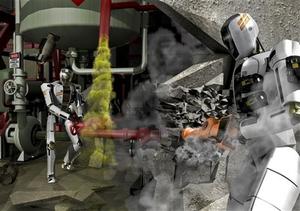RoboticsSeventeen teams to compete in DARPA Robotics Challenge Trials
Four teams that built full robot hardware and software systems using their own funds qualified to join thirteen other teams to compete in the Defense Advanced Research Projects Agency (DARPA) Robotics Challenge (DRC) Trials. The event will take place 20-21 December at the Homestead-Miami Speedway in Homestead, Florida, where spectators can observe as the robots are tested on the capabilities that would enable them to provide assistance in future natural and man-made disasters.

DRC looks for adaptable robots to respond to natural and man-made disasters // Source: defense.gov
Four teams that built full robot hardware and software systems using their own funds qualified to join thirteen other teams to compete in the Defense Advanced Research Projects Agency (DARPA) Robotics Challenge (DRC) Trials. The event will take place 20-21 December at the Homestead-Miami Speedway in Homestead, Florida, where spectators can observe as the robots are tested on the capabilities that would enable them to provide assistance in future natural and man-made disasters. A DARPA release reports that the new teams are:
- Team Chiron (Kairos Autonomi from Sandy, Utah, USA)
- Team KAIST (Rainbow Co. from Daejeon, Republic of Korea)
- Intelligent Pioneer (Institute of Advanced Manufacturing Technology, Hefei Institute of Physical Science, Chinese Academy of Science from Changzhou, Jiangshu, China)
- Team Mojavaton (Mojavaton LLC from Grand Junction, Colo., USA)
“The DARPA Robotics Challenge was designed to catalyze the robotics community to help mitigate the effects of future disasters, so it is rewarding to see such diverse, international participation,” said Gill Pratt, DRC program manager. “DARPA structured the challenge to encourage participation by experts in hardware and software alike since both fields are necessary to provide a realistic baseline on the current state of robotics. The diversity of approaches we expect to see demonstrated at the DRC Trials will mark the beginning of an important transformation in robotics, and these approaches will be further refined going into the DRC Finals in 2014.”
The new teams join 13 others that will attempt to complete eight physical tasks based on actions a human first responder might have to take in a real disaster situation. The tasks, described on the DRC Trials website, will test the human operators and their robots in the areas of: autonomous perception, autonomous decision-making, mounted and dismounted mobility, dexterity and strength.
During the Fukushima nuclear meltdown, which drove creation of the DRC, the simple act of turning a valve and venting hydrogen in the reactor buildings might have prevented catastrophe. That single capability, however, is not enough for an effective disaster response robot. Disasters are unpredictable in their manifestation and effects, so the type of robots DARPA envisions to aid in these situations must be adaptable. The DRC Trials tasks require robots to demonstrate that they can move from a sanctuary area to a danger zone and then work effectively once there. All eight of the tasks to be tested are deemed equally necessary.
During a pre-qualification round in November, teams had their robots complete three basic actions to demonstrate their safety and readiness to participate in the DRC Trials. The robots had to approach and climb over a small barrier, walk through an open doorway, and rotate a valve 360 degrees, in addition to demonstrating a complete emergency stop. The results provided an indication of what to expect during the trials: many of the robots will move slowly and quite deliberately through the tasks. Similar to a one-year-old child beginning to walk and interact with the world, there will be stumbles and falls. Like the DARPA Grand Challenges events in 2004 and 2005, however, that first tested driverless vehicle technology, the DRC teams are expected to show extraordinary improvement in the year between the DRC Trials and DRC Finals.
“DARPA has successfully used incentive-based Challenges over the past decade to attract innovators from around the world to develop leap-ahead technology capabilities,” Pratt said.
“The diverse participation in the DRC will reinforce the openness that the international science and technology community shares, and move us to a future in which capable disaster response robots can help us save lives and prevent loss.”
The DRC Trials are free and open to the public and media. In addition to the competition, the on-site DRC Exposition will showcase technology related to disaster response, robotics and autonomy. It will include, among others, demonstrations of DARPA’s “Wild Cat” (an untethered, all-terrain version of the “Cheetah” robot) and the Legged Squad Support System. More information can be found at the event’s Web site.
